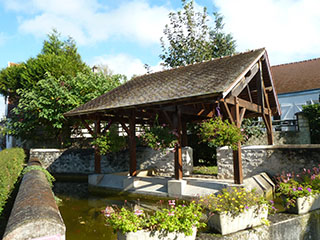Prochain point :
Ensemble de maisons rurales
Prochain point : lat="49.03952" lon="1.68927"

The washhouse
Improvements in daily life
The management of drinking water...
From the mid-nineteenth century, the state introduced the "Napoleonic" land registry to define public space and accurately determine property ownership. The town launched into an ambitious water supply project, drawing water from Désirée spring, whose flow rate (estimated at 35 liters per minute) was deemed sufficient to supply the public fountains. Work began in 1880 with the construction of a reservoir and the installation of seven fountains. The people of St. Martin were connected to the water supply network. Unfortunately, the flow gradually dried up as the pipes deteriorated. In 1897, a second spring was tapped into, that of La Mine, below Hutrel mound.
To consolidate the drinking water supply, Herville spring was tapped into 1927. Connecting pipes were installed to homes the following year. It was not until 1936 that the hamlets of Coudray, la Villeneuve and Sandrancourt were connected.
... And an unusual washhouse
Built in the heart of the village in 1865, the washhouse is fed by Désirée spring. The village women used it until early 1950, when it was demolished due to obsolescence. It was rebuilt in 2005. The originality of this washhouse is the unique triangular pool, protected by low walls. The washing area is covered by a gable roof supported by rectangular wooden posts. The two series of washing boards are still visible on the ground.





